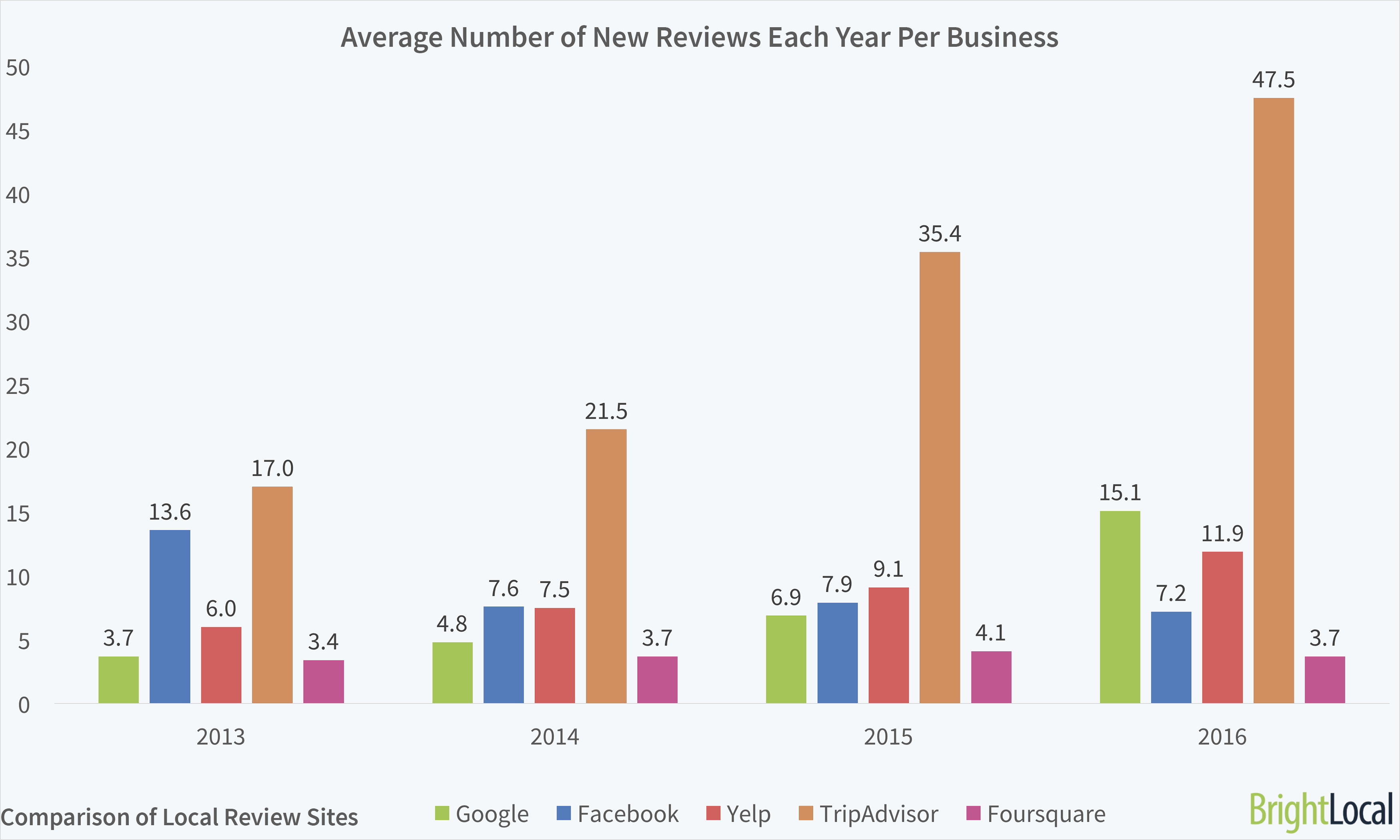Brand Development, Web Design, and Google Analytics Specialists
Experienced in SEM, SEO, Social Media, and Traditional Media
The Top 11 Benefits of Guest Blogging

* Original article *
Guest blogging is one of the best online marketing strategies you can invest in.
If you want to spread your brand’s message and win the trust of your target audience, start contributing content to other blogs related to your market or niche.
Not convinced you should work hard writing content for someone else’s site?
You should know that guest blogging offers many major benefits – both for your company and you, personally.
Here are the top 11 benefits of guest blogging.
1. Instant Exposure to Targeted Traffic
Regardless if you whether you get a link to your site, contributing to other blogs should pique your audience’s interest. If you manage to write a top-quality post, expect traffic to start flowing to your site once it goes live.
Traffic is the lifeblood of any online business or blog. Something as simple as a guest post can potentially translate into sales if you do it the right way.
Optimize your website’s landing pages, CTAs, and other elements to boost your chances at conversion.
2. Expand Your Personal Network
There was a time when connecting with influencers was extremely difficult. But with guest blogging, the process is now simple.
For example, some websites that accept guest posts foster a community of contributors engaged in related niches. In some cases, you’ll get the chance to take part in an email thread where contributors brainstorm potential topics. You can also collaborate with others for co-authored posts.
Regardless of what the community’s structure in a particular site is, you can always leverage your authorship. Seek partnership opportunities with influencers – from content cross-promotion to expert interviews.
All you need to do is be active in the community. Leave comments, share other posts, or cold-email your prospects. If possible, you can even invite influencers as contributors to your own blog.
3. Stimulate Social Media Shares
Generating social media shares is one way to exponentially extend your online reach. The more shares your branded content gets, the more shareworthy it’ll be in the eyes of your audience.
If you’re submitting a guest post to a blog with plenty of social media activity, then shares should come naturally once your content gets published.
To get the ball rolling faster, consider embedding highly shareable content in your guest post. Infographics, for example, can help you get 3x more engagement in social media than any other type of content.
4. Grow Your Social Media Following
Guest blogging not only increases the amount of social media shares to your content, it can also boost your follower count and accelerate your lead generation efforts.
By contributing to an authoritative blog, you are essentially getting them to vouch for your brand. This makes you look good in the eyes of their followers.
In most guest blogging arrangements, you also get to customize your contributor profile. Here you can include links to your social media accounts.
All these benefits will make it easier to win your target audience’s trust and turn them into active social media followers. Remember to reward them by posting regular updates and sharing useful information that aligns with their interests.
5. Improve Your Online Authority
Modern online marketing is all about authority. Even with the best content in the world, it’ll be difficult to convert your audience into loyal subscribers or paying customers if they don’t trust your brand.
By contributing to other authoritative blogs, you get the chance to prove your credibility as an information source. It will make your target audience realize that you’re someone who’s recognized by trustworthy brands. And as a result, they’ll be more receptive to any value proposition you may present in your own site.
6. Fortify Your Backlink Profile
Most blogs that accept guest posts allow their contributors to leave at least one link to their own site. After all, most of them don’t offer any monetary compensation for your hard work. A brief brand mention or keyword-optimized link is the least they could do to reward your efforts.
Still, even a single backlink from an authoritative blog will greatly benefit your SEO. They make your content more discoverable and indexable to search engines like Google. As much as possible, try to target websites in your own niche to build relevancy.
7. Grow Brand Awareness
Guest blogging is a great way to establish your authority in your niche.
As much as possible, try to share practical tips that aren’t already found elsewhere.
Leverage the opportunity to let them know what your company does and how it would solve problems.
Also, be sure to instill your brand’s voice into every single post you submit. This will make your personal brand more recognizable regardless of where you submit guest posts.
Some popular bloggers, such as Larry Kim, use a conversational and humorous approach to engage readers. They also avoid writing fluff while keeping sentences short and easy to read.
8. Generate Qualified Leads
One of the fundamental steps to a successful guest blogging strategy is picking the right websites.
In addition to niche relevancy, you also need to look for sites that already have a steady stream of traffic. This will help you connect with people who are already interested in what you offer as a business.
Always emphasize an actionable step when developing the page that you’re bringing traffic to. It should be related to the guest post you’ve submitted to the other blog. Otherwise, your link is nothing more than a disruption in your audience’s journey — a waste of time for them and a lost lead for you.
9. Shorten the Sales Cycle
The sales funnel has always been a challenge for content marketers. By distributing content through popular blogs, you are immediately building your target audience’s familiarity with your brand. Thus, you are shortening the sales cycle for your products and services.
Think of it this way: rather than waiting for potential leads to come to your site, you can introduce your brand’s value propositions in your guest posts.
You just need to be smart when picking or pitching topic ideas for your guest posts.
10. Get Useful Feedback from the Community
As a guest blogger, another advantage of being active in the community is that you get to receive insightful feedback from other contributors.
When you talk about strategies, for example, other experts may tune in to share their own ideas through the comments section. As a result, you can further develop or refine your strategy with their suggestions in mind.
To invite contributors to comment, try adding a call-to-action in the conclusion paragraph. You can refer to the end of this post to see how it works.
11. Sharpen Your Content Marketing Skills
Guest blogging requires every area of content marketing to be successful. It requires you to do content research, adopt the right writing voice for a particular audience, perform influencer outreach, and so on.
Remember, the best way to learn content marketing tactics is to deploy them yourself. You can’t just read about them, follow everything to the letter, and hope for the best.
By launching your own guest blogging campaign, you’re positioning yourself for growth in every facet of content marketing.
Conclusion
Guest blogging is, without a doubt, a crucial step for online marketing success. Once you grasp its benefits, give it a shot and see if you can make it work for your brand.
5 Perks of PPC Advertising for Your Business

There is amazing value in launching PPC advertising because of the major positive impact it can have on your business. As a refresh, PPC means “Pay per Click,” and is a popular online advertising form facilitated through Google Adwords, Bing Ads, Facebook Ads, and Twitter promoted tweets. As the term implies, you only pay when someone clicks on your ad.
What makes PPC great is the ability to reach a targeted audience quickly by selecting who will see your ads, whether through entering specific keywords or demographic characteristics.
If your business isn’t utilizing PPC advertising then you’re losing out on valuable traffic and a revenue generating stream. Here are a few reasons why PPC supports and benefits business:
- Supports business goals
- Low barrier to entry
- Ability to target
- Works with other marketing channels
- Measurable
1. PPC Supports Business Goals
Whether your goals are high-level brand awareness, targeted lead generation, or e-commerce sales PPC has the capacity to contribute to the success of these goals. It’s the most compelling argument for integrating a PPC strategy into your overall marketing strategy.
Really any type of conversion goal can be tracked, making it an incredibly useful tool for driving traffic to complete end goals. However, we caution to start slow, measure and grow big. Start with a simple campaign, measure the results, and depending on the results determined you can spend more money or adjust the audience and keep going.
If you’re already churning out content, use PPC to amplify your content marketing goals. PPC fosters the middle of the funnel through advertising content downloads, giveaways, contest entries, app downloads, newsletter signups, etc. Whatever your set goals, PPC campaigns can be created to effectively support them.
2. Low Barrier to Entry
Very little is needed to get a PPC campaign up and roaring. Compared to traditional media, which has a lag time while waiting for your ad to go to print or your billboard to go up. With an online campaign all you need is a website and something to sell, and you can get your campaign running immediately across a wide net of people to uncover new prospects and customers.
Better yet, much of the work is completely within the platform itself. From research to campaign build out, you’ll require little aside from help setting up conversion tracking, ad graphics, and landing pages.
3. Ability to Target
There are 290 million internet users in the USA alone, and 3.5 billion total across the globe. The numbers are insane when it comes to the amount of people you can reach today with online marketing. PPC provides the ability to reach massive audiences or extremely niche audiences.
Consider your target market: Are they English or Spanish speakers? What are their interests? Where do live? What are their aspirational goals? Are they iPhone or Android users?
The parameters are endless and it’s up to you to determine and figure out the audience that best fits your product or service. Then hit them with an ad they can’t ignore.
4. PPC Complements & Works with Other Marketing Channels
Within your complete digital marketing plan PPC is so important that it can work as the base of all you do. Digital marketing consultant, Alex Chris, summed up perfectly the ways PPC works works exceedingly well with other marketing channels:
You can use dynamic search ad campaigns and let PPC tell you which keywords are a good match for your website.
You can use PPC to test the effectiveness of different keywords so that you know which keywords to target with long term SEO.
You can use PPC as a way to get more installs for your mobile application and strengthen your mobile marketing.
You can use PPC to get more email signups and enrich your email marketing campaigns.
It’s great for local SEO optimization – You can use PPC to drive customers to your shop door or get direct calls from customers looking for products and services in your area.
5. PPC is Measurable
Metrics and relying on data for decisions is vital for success. A major benefit of PPC is that it’s simple to measure, track, and learn from. Just use the Adwords tool with Google Analytics to garner the most robust results.
You’ll uncover an amazing wealth of information about your audience. You can see who is interested, what they’re interested in, and why they may have decided they’re no longer interested. The clearest picture on what kind of traffic and results you’re generating from your budget will be gleaned easily. No other marketing format can provide such immediate and accessible results.
8 Old School Marketing Tactics That Work for Social Media

Link to Original article
Okay, so it’s hard to imagine Don Draper meeting with Bethlehem Steel execs in Sterling Cooper’s top floor Madison Avenue boardroom, telling them to get on Snapchat. But even though we no longer think of typewriters as “technology” or describe TVs as “radios with pictures,” there are plenty of solid ideas from the Mad Men-era of advertising that translate to social media.
So let’s throw it back to a time before #ThrowbackThursday existed for some good old-fashioned advice from the old-school pros.
1. Doing smart, thorough research
In the premier episode of Mad Men, Don Draper trashes an in-house researcher’s report on the psychology of cigarette users and decides to wing a presentation for Lucky Strike executives instead. While Draper pulls it off, not all ad executives were so cavalier.
“Advertising people who ignore research are as dangerous as generals who ignore decodes of enemy signals,” said David Ogilvy, the founder of Ogilvy & Mather who was credited as the “Original Mad Man” and the “Father of Advertising.”
Ogilvy’s experience at Gallup’s Audience Research Institute taught him to value data way before Big Data became a thing. His knack for research-supported copywriting is best exemplified in his headline for a 1960s Rolls-Royce ad, widely considered one of the best auto taglines of all time.

Nowadays, social media marketers looking to emulate the OG Mad Man’s advice should support their strategies with analytics platforms and research-backed ideas.
2. Learning the rules, then breaking them
There are more game changers in the Advertising Hall of Fame than there are rule followers.
“Rules are what the artist breaks; the memorable never emerged from a formula,” said ad exec William Bernbach, creative director who co-founded the agency Doyle Dane Bernbach in 1949.
Bernbach’s “Think Small” campaign for Volkswagen in the 1960s threw out the rulebook for traditional print ads. To sell the compact Beetle to muscle car-crazed Americans, Bernbach’s team departed from convention by picturing a very tiny car on a page filled mainly with blank space. The small idea translated to a big boost in sales and brand loyalty.

Rule breaking may seem trickier on social media, but it’s still possible. BETC’s “Like My Addiction” campaign caught more than 100K Instagrammers by surprise with the reveal that the Parisian “it girl” Louise Delage was a fake account designed to portray a textbook alcoholic. Created for French organization Addict Aide, the initiative demonstrated that it can be difficult to spot signs of youth alcoholism.
3. Avoiding sleazy bait-and-switch tactics
Known as the world’s first female copywriter and the author of the first ad to use sex appeal, Helen Lansdowne Resor was keeping advertising real long before the ad men of the swinging 60s and 70s came onto the scene.
Her conviction that “copy must be believable,” can be found throughout her entire body of work, including her early copywriting for Woodbury Soap Company in 1910. Smooth taglines like “A skin you love to touch,” and “Your skin is what you make it” remained in circulation for decades.

Social media marketers can take Lansdowne Resor’s point in two ways. First, copy should not be too over-the-top or exaggerated, especially since teens are skeptical when it comes to trusting brands. Avoid empty platitudes or superlatives that may arouse doubt.
Second, don’t lie. Millennials are 43 percent more likely than other generations to call a brand out on social media. You dig?
4. Getting right to the heart of things
It’s hard to imagine that the “I ❤ New York” slogan was invented in a pre-emoji world. Sparse in word count and minimal in design, the logo is emblematic of co-creator Jane Maas’ direct approach to advertising.

In How to Advertise, a book Maas co-wrote with colleague Kenneth Roman, she explains, “Commercial attention does not build. Your audience can only become less interested, never more. The level you reach in the first five seconds is the highest you will get, so don’t save your punches.”
The advice is eerily applicable to video marketing in the current digital media ecosystem, where attention spans are running shorter than ever, especially among today’s teenyboppers. You must catch your audience’s attention immediately, or risk losing them entirely.
Check out The Four Key Ingredients of a Perfect Social Video for more pointers on creating punchy video campaigns.
5. Using the right imagery
Inspired by a sea lion performance at a zoo, John Gilroy developed the “My Goodness, My Guinness” for the Irish beer company in the late 1920s. The series depicts a flabbergasted zookeeper prying his beer from the arms of a polar bear, the pouch of a kangaroo and the jaws of a crocodile. And, of course, a toucan.
The humorous misadventures of the zookeeper pop with vibrant colors set against an often-white backdrop. Keen observers point out that it was Gilroy’s uniform use of typography that helped solidify Guinness’ brand image. The popularity of the artwork and consistency of style made it one of the longest advertising campaigns in history.
Using images is a great way to up your social media game, especially since visuals can aid in information retention. Marketers should ensure that photos complement branding and style guidelines. And where possible, add the logo and logotype to the image. Consistency in style is a bonus, but it will help your followers recognize your brand on any platform.
If you don’t have access to artists, photographers, or graphic designers, check out these resources for creating quick and beautiful images for social media.
6. Ditching the one-size-fits-all approach
As the first black man in Chicago advertising, Tom Burrell quickly saw that advertising boardrooms had a diversity problem. Too often, ad execs would create content for white audiences and expect it to have broad appeal. Or, they’d create a commercial for white actors and film a second version with black actors.
After witnessing a number of tone-deaf gaffs and insensitive blunders, Burrell found himself repeating to his colleagues, “Black people are not dark-skinned white people.”
By advocating for tailoring messages for specific communities, he was one of the first to pioneer ethnic micro targeting in advertising. He founded his own agency, Burrell Communications, in 1971 and quickly became the authority on crafting messages for African-American audiences.
In work he did for McDonalds, Burrell reasoned that the company’s slogan “You deserve a break today” sounded too occasional for many African Americans who had a more regular experience with the fast food chain. Instead, he came up with lines like “Sure is good to have around” and “Get down with something good at McDonald’s.”

With Gen Zers forming the most ethnically diverse population in U.S. history, Burrell’s approach is one that social media marketers should put in practice.
Here’s how to find your audience on social media.
7. Knowing that context matters
In 1970, advertisers working for Schaefer beer created a print ad to commemorate the company’s tradition of producing America’s oldest lager. The minimal layout was designed to place emphasis on the year Schaefer’s lager was introduced, with a 10-word tagline reading: “1842. It was a very good year for beer drinkers.”
The two-page ad was placed in a number of popular publications such as LIFE Magazine. But its placement in Ebony Magazine, a publication with a predominantly African American readership, drew criticism.
As Tom Burrell points out in an interview with NPR Planet Money, the year 1842 in the United States was a year many black people were enslaved. “It just screamed insensitivity,” he says. “It was a horrible year for us.”

Getting context wrong can make a brand appear ignorant at best. At worst, it can cause lasting damage to a brand’s image.
Getting context right, on the other hand, can have a positive effect. Wells Fargo adapted its television commercial so that would be optimized for Facebook, where viewers prefer shorter content and may watch videos without sound. To promote the launch of Friends and prove the show’s relevance, Netflix’s Pre-Roll campaign shows viewers a clip related to the YouTube video they’re about to watch.
Social media marketers should shift from cross-posting to cross-promoting, with content tailored to suit each platform.
8. Engaging the audience in a conversation
In the 1950s, American advertising executive Shirley Polykoff’s personal approach to copywriting convinced women across the United States to colour their hair. By posing the question “Does she… or doesn’t she?” in Clairol hair-dye commercials, she reassured women that a hair colouring—then a new fad—could look natural.
“Copy is a direct conversation with the consumer,” she said. Her lingo was so effective that it’s now part of the vernacular: “So natural only her hairdresser knows for sure” and “Is it true blondes have more fun?” Who knows, maybe if she’d worked on a campaign for Rogaine we’d still be using the phrase Chrome Dome.

Besides being concise and memorable, Polykoff does something important in her copy that all modern social media marketers should take note of—she asks a question. Posing questions to your audience is a great way to get followers engaged and increase the visibility of your campaigns, such as Airbnb’s #TripsOnAirbnb campaign.
To get the conversation going on social media, Airbnb asked followers to describe their perfect vacation in three emojis. Not only did the prompt generate hundreds of responses, but Airbnb kept the conversation going by responding to each submission with Airbnb Experience suggestions. Remember, if you want to start a convo, follow-through is key.
More brands have been exploring the opportunities to engage via direct messaging, too. To jumpstart conversations between brands and users, Facebook just introduced Click-to-Messenger ads.
Email Marketing Segmentation Strategies that Grow Your Business
Email marketing segmentation is a huge boon for businesses. Marketers know segmenting emails into various groupings not only improves open rates, but also click-through rates that ultimately lead to conversions.
Recent data provided by Mailchimp reveals that segmented campaigns receive 14.31% more opens and 100.95% more clicks.
Now more than ever, segmentation is proving to be a greatly effective strategy for businesses looking to drive customer engagement and sales.
It’s All About the Group
Email segmentation is all about the group, and the art of positioning subscribers into groups based upon different factors like: behavior, interests, age, gender, location, and so on. Depending on your industry and goals, the factors will adjust accordingly.

According to DMA, marketers have found 760% increase in email revenue from segmented campaigns. This begs the question, if all your subscribers are different, why are you treating them like they’re all the same?
Established groups should be diverted into buckets fitting the factors you’ve outlined that then serve them specific and curated content and offers they’re most likely to take an action on.
What’s even cooler about segmentation is you can tap into your subscriber’s aspirational self, and not just target based upon where they are in their customer lifecycle. A tactic expertly used by luxury brands.
Segmentation Strategies:
Before dividing up your contact list it’s important to understand a few different proven segmentation strategies. In fact, these are strategies you can immediately adopt today so you can start seeing results tomorrow.
1. Demographics
Demographic data is your launching pad for segmenting your email subscribers into specific lists. Demographic data includes factors like age, gender, income level, company position, education, etc. Seemingly simple demographic data can tell you a great amount about your customer’s wants and needs, and therefore how you can serve them and even turn them into raving fans.
Our recommendation is to acquire as much demographic data from your customer upfront, without scaring them off of course. Whether they’re filling out a form to sign up for your newsletter or are in the purchase process, this is your opportunity to start them off correctly in your email funnel.
For example, if you’re an outdoor retailer, gender is probably at the top of your list so you know which products to suggest to your customers. If you’re a marketing consultant, then knowing your customer’s job title is valuable.
What metrics are the most integral for you business? Be sure to include these in your customer’s signup process.
2. Email Engagement
What better way to sort your customers than by the way they interact with the messages you’re already sending? Segmenting based on email engagement is a simple and effective method that will have a major impact on your results.
Thankfully email marketing services already do a bit of the leg work for us by providing open and clickthrough rates on each email you send. With these metrics you discover your active vs. inactive users.
An inactive user would be someone who hasn’t open an email in three months or more. This is a customer you want to bring back into the fold. Tailor a campaign to re-engage them, whether through a discount offer or a “hey we haven’t seen each other in awhile, check out what’s brand spanking new” type message.
Conversely, you can reach out to your customers that are highly engaged and repeat buyers. We’d call these people your fans. Announce to your fans about an upcoming sale that they’re receiving exclusive first-access to since they’re a loyal customer. If they clickthrough then mark them as “interested” or whatever label you deem appropriate. Then you can develop a specialized campaign to further target them as consistent (maybe even reliable) buyers.
3. Geographic Area
For businesses where geographic location makes a big impact on purchasing decisions then segmenting based on geographic location data is paramount.
A great example of a brand doing this right is Spirit Airlines. Every customer that uses Spirit must filled out basic information like sex, age, and address. The address category is what allows Spirit to target its customers based upon location.

If you’re living in San Diego, why would you care about flight deals out of Denver? You wouldn’t. And this is why geographic location data segmentation is powerful.
Spirit is able to target and supply customers with information, deals, and fun trip facts based upon where you live and where you’re headed. Thus driving open rates and engagement.
Here are a few more examples of ways to use geographic data:
- Location-specific content: Offer a personalized experience by including a specific location in your headline and/or content
- Advertise regional promotions: Offering a Pacific Northwest specific sale? Send focused emails for this promotion to customers in the region.
- Time-based: Send out email at optimum times for customers in different time zones
4. Personal Interest
This is where it gets a little trickier, however if you can pull it off it will greatly help with granular segmentation strategies. You can gain information on your customer’s personal interests by creating user profiles on your website or by using an email subscription center where they can tick off their purchasing or information interests.
You can invite them to do this either in the signup process or encourage them down the road in follow up emails to complete their profile online. Having this information is an amazing tool to help you target customers effectively, and avoid wasting their time with let’s say tech products when their only interest is in beauty products.
In conclusion, email marketing is a highly effective tool that when used correctly can not only nurture your current customer base, but also grow it to unprecedented levels. All you need is a simple email marketing service, knowledge of your customers, creativity, and the drive to build out these segmentation strategies.
Here are a few email marketing services we recommend:
Contact us to learn how we can help your business with email marketing strategies!
Comparison of Local Review Sites: Which Platform is Growing the Fastest?

* Original article *
- Google is the review platform that consistently gains the highest number of new reviews, followed by Facebook, then Yelp
- The average business got fewer new reviews on Facebook in 2016 than before – suggesting a lack of engaged reviewers
- TripAdvisor achieves the most new reviews per business on the platform
- Which ‘local’ review site has seen the greatest and fastest growth in new reviews over the past five years
- How each of these leading ‘local’ review sites has grown year on year, and month by month
- Whether any review sites are experiencing a slowdown of growth
Methodology
We analyzed the review data of approximately 50,000 US-based businesses using data gathered in our ReviewFlow reports. The data set comprises a broad sample of local businesses from many different categories; the data has been aggregated and anonymized.
The data stretches back as far back as online reviews do, but we chose to focus on the past five years (2012-2017) for annual comparisons, and the period July 2016 to July 2017 for a more in-depth look.
We focused the study on five of the most prominent local review sites – Google, Facebook, Yelp, Foursquare, and TripAdvisor. Four of the review sites carry listings and reviews for business in all industries. The fifth, TripAdvisor, was selected due its popularity and prominence in the online review world, and to provide a contrast to the generic review sites.
We chose to include Foursquare because it was once the darling of local-social engagement, and accumulated a lot of reviews and ratings data on local businesses. In recent years Foursquare has pivoted to focus on providing Location Intelligence to help businesses reach local consumers, but they still operate two local-social apps which engage local consumers.
We didn’t look at product or general review sites (e.g. Amazon, Trustpilot) as we are focused on understanding the impact of reviews on ‘local’ businesses (SMBs & Enterprise).
Cumulative Growth in Reviews (2012-2017)
This chart explores the cumulative growth of reviews on the five review sites we analyzed.
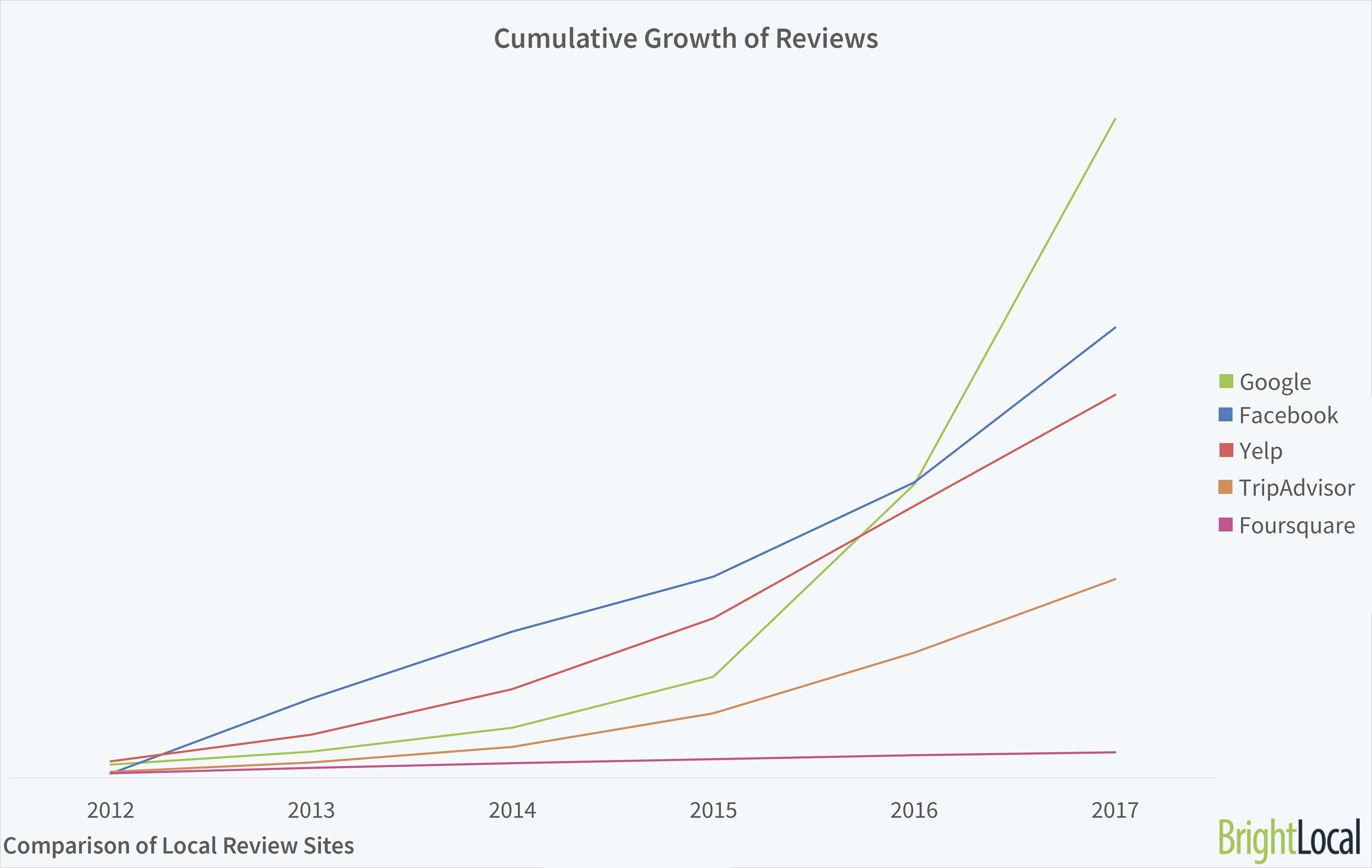
Fastest growing review sites:
- Yelp
- TripAdvisor
- FourSquare
Since 2015, Google has seen the most dramatic increase in the quantity of reviews compared to the other review platforms. Yelp, Facebook and Tripadvisor have all seen an acceleration in their accumulation of reviews – so this is a positive story for all of them – but Google is growing the fastest by far.
Google’s sheer scale coupled with its native integration into Android devices gives them both the biggest audience and the best route to market to prompt users to leave reviews for recently visited businesses. See below for more on this.Foursquare is the only review platform that has plateaued over this period, which isn’t surprising given the company’s change in focus.
Review Growth Compared To Previous Year
This chart shows the percentage growth in the number of new reviews for each site vs the previous year. From this chart we can determine the rate of growth and which site is accumulating reviews the fastest.
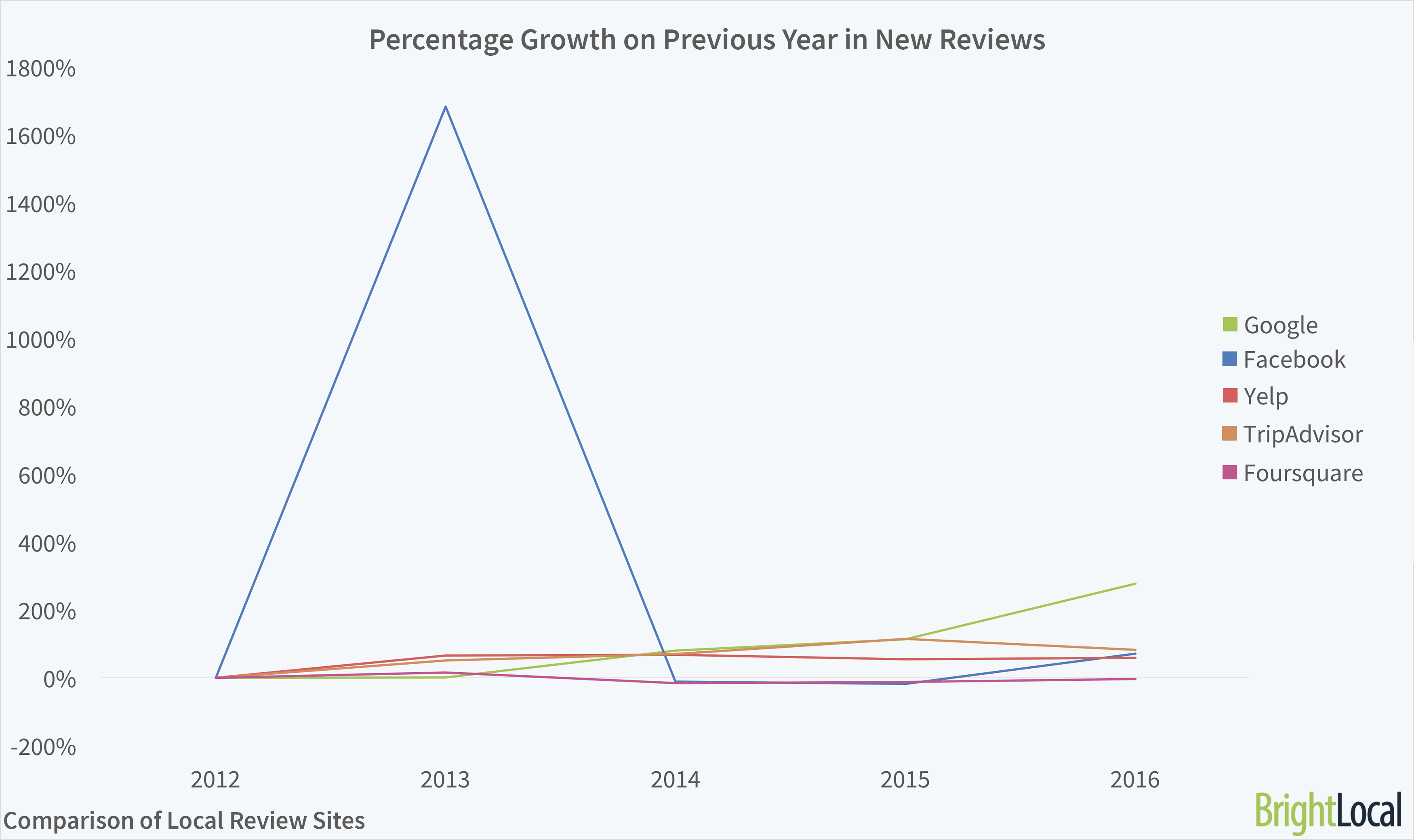
The big story here is the massive jump in new reviews that Facebook saw in 2012-13. This was around the time they first enabled reviews on their service and focused on encouraging users to write reviews, so they saw significant growth from a very low base.
From 2013-2015, Facebook grew slowly, until a big uptick in reviews in 2016.
Review Growth Compared To Previous Year (adapted)
This chart is the same as the one above, but we have ‘flattened’ the spike in Facebook reviews in 2012-2013 to enable us to see the growth in the other review sites.
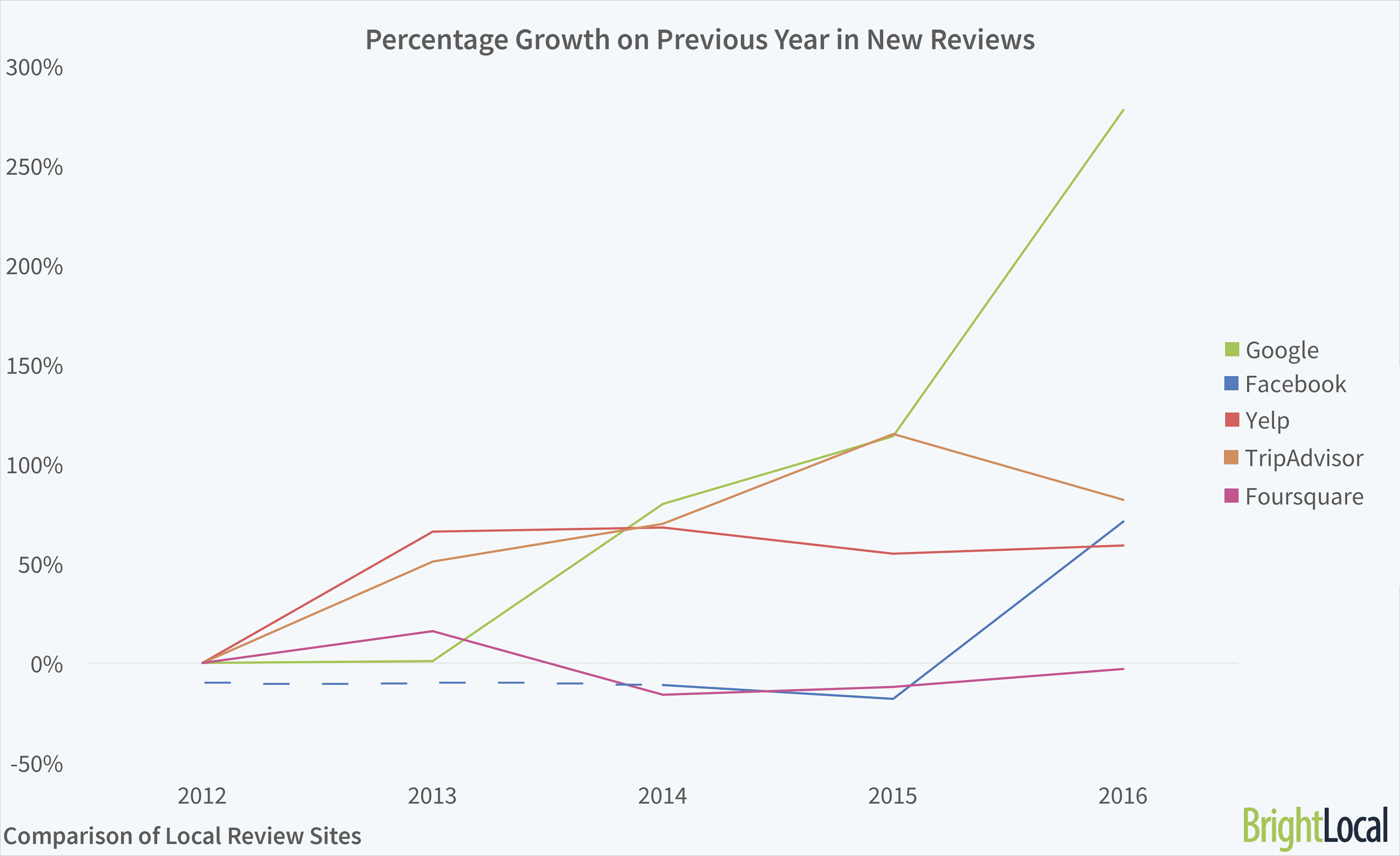
Key Findings:
- Google is acquiring reviews at the fastest rate – new reviews jumped 278% in 2016 from 2015
- TripAdvisor is the second fastest-growing review site – up 82% in 2016 (but slowing from 115% growth in 2015)
- Facebook’s accumulation of reviews was slow in 2014 and 2015, but then it significantly jumped in 2016
- Yelp’s review growth has slowed since 2014 – but is still growing
- Foursquare is the only review site to consistently receive fewer reviews than in the previous year
| Review site | 2013 | 2014 | 2015 | 2016 |
| Yelp | 66% | 68% | 55% | 59% |
| 1683% | -11% | -18% | 71% | |
| Foursquare | 16% | -16% | -12% | -3% |
| 1% | 80% | 114% | 278% | |
| TripAdvisor | 51% | 70% | 115% | 82% |
Average Number of New Reviews Per Business
This chart shows the average number of new reviews gained in each year for a business using the platforms.
When looking at the average number of reviews a typical business has on each platform, TripAdvisor is the clear frontrunner. In 2016, each business in our sample gained an average of 47.5 new reviews – triple the amount the average business on Google received. Read more on TripAdvisor below.
While TripAdvisor may get fewer total reviews than Facebook, Google, and Yelp overall, it receives a far higher concentration of reviews per business across its specialism. Want to find out more about niche review sites for any industry? Take a look at our list of 300+ specialist review sites.
As expected, Foursquare sees the lowest average new reviews per business over the period 2013 to 2016. In fact, the platform has seen little change over this period – peaking at 4.1 new reviews per business, and dropping to 3.4 at its lowest point. It seems like Foursquare is plodding along steadily – acquiring reviews in a consistent scale to the number of businesses using the platform. For more on what’s happening with Foursquare, see below.
Yelp and Google are both adding reviews at scale – having seen increases in the average number of new reviews per business over the last few years. Yelp has been increasing steadily in acquiring reviews per business, growing by around two reviews per year to a peak of 11.9 in 2016. Find out more on Yelp below.
Facebook saw a small drop in new reviews per business in 2016. However, this is not to assume the platform is seeing a downward spiral. Facebook reviews started with a huge jump in 2013, with businesses opting to use this platform receiving an average of 13.6 new reviews each in 2013. In 2016, a typical business received 7.2 new reviews. This decline in average could be down to the high number of businesses on Facebook – with less engagement from users regularly leaving reviews for businesses.
Of course, Facebook’s primary function is as a social network, so leaving reviews can be of secondary importance for users. Clearly, businesses have realized the importance of having a presence on the platform – but the platform needs to encourage users to leave reviews if they are to really compete with Google. Read further trends on Facebook here.
Yelp, TripAdvisor, and Google all have more reviews per business than Facebook – suggesting that these three sites have a more active audience that are engaged and leaving reviews. For Yelp and TripAdvisor, this is likely due to reviews being their key focus – with users only on the site to read or leave reviews.
Google received significantly more reviews per business in 2016 than the previous years – more than doubling new reviews per business (15.1, up from 6.9). Read more about Google here.
Google doesn’t solely focus on reviews, but is an integral part of finding a local business. Mobile location tracking means that Google can send queries to users asking for reviews for places they’ve been. From here, users can easily submit short reviews with photos directly from their devices (as shown below).
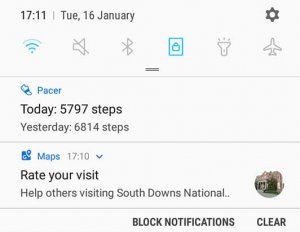
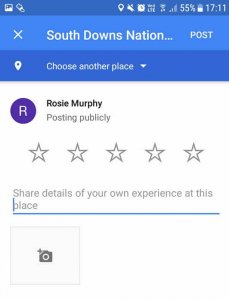 This means users are encouraged to submit regular, ‘everyday’ reviews just because they are asked to – rather than seeking out a business on a review site due to a notably good or bad experience.
This means users are encouraged to submit regular, ‘everyday’ reviews just because they are asked to – rather than seeking out a business on a review site due to a notably good or bad experience.
Number of New Reviews Written Per Month (July 2016 – July 2017)

The period July 2016 – July 2017 highlights a number of trends across the review platforms in greater detail. We delved into the number of reviews each platform gained every month in that period.
- Google continued to lead in the number of new reviews – with significant increases in 2017
- Facebook also saw strong growth in this period – but at a slower pace than Google
- TripAdvisor and Yelp grew slowly and steadily
Generally, the months in our time period in 2017 outperformed the months in 2016 – signifying further acceleration of growth for most of the review sites.
Google saw a significant increase in the number of new reviews – pulling quickly ahead to leave everyone else in the dust. It saw a 40% increase from April to May 2017 in the number of new reviews per month. While there was a small drop the next month, this ramped up again in July. By July 2017, the businesses were receiving more than double the amount of new reviews they were just a year before.
On Facebook, the businesses in our sample saw a significant growth in the number of new reviews from September 2016 – growing 33% in just one month. Between August and December, it more than doubled the number of reviews per month – and continued growing in 2017. Our sample suggests that Facebook has lots to be proud of in this time period – growing from a similar number of reviews as TripAdvisor in July 2016, to an increase of 133% a year on.
Curiously, May 2017 proved to be a great month for Google, Facebook, and TripAdvisor. If you’ve got any thoughts on why this might be, leave us a comment below.
Perhaps unsurprisingly, there appears to be a summer peak for TripAdvisor, with August, July and October leading in 2016 – although the months March to July 2017 outperform every month in 2016. It’s no surprise that this correlates with the high season for holidays and trips out.
Yelp received a steady number of reviews – performing well throughout the time period with a surprise peak in October 2016 that even overtook Facebook for the month. It soon dropped back to its former position, with a slow and steady increase in the number of reviews each month.
Foursquare was the only platform of the five that didn’t show a clear trend of increased reviews over the time period. But with these numbers being a fraction of their nearest competitor, the lack of correlation is not a shock.
Trends by Review Site
Google Reviews

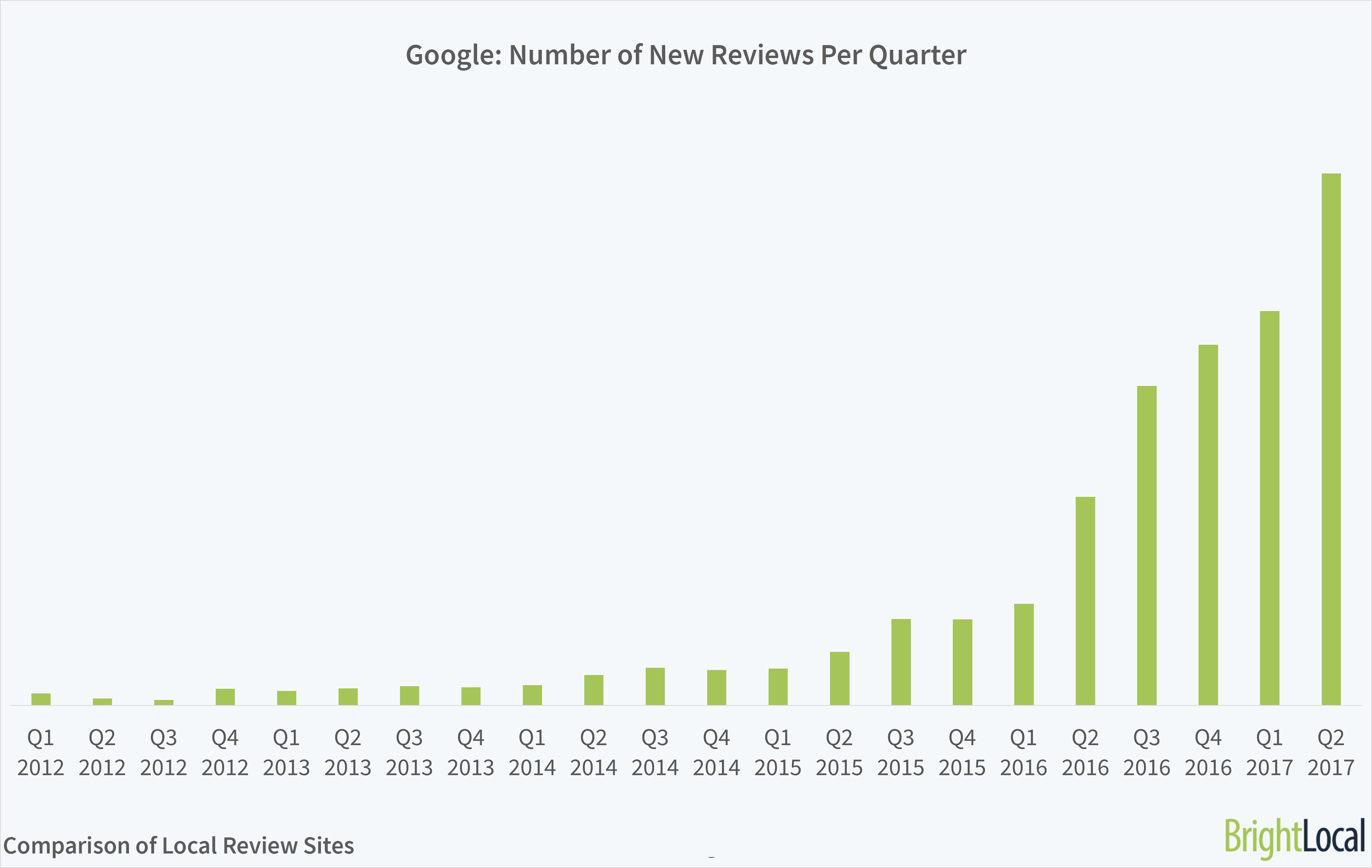
Google has told an interesting story, placing third for number of reviews in 2014 and 2015, and jumping into pole position from 2016. The businesses in the study saw a huge uplift in reviews in Google – seeing an increase of 278% in 2016 from the year before, and acquiring significantly more in the first half of 2017. While it may have had a slow start, the powerhouse is growing every quarter to lead in numbers of reviews.
From the days of Hotpot, Google has placed itself as a source of recommendations. So much information is now available in SERPs and the Google environment, it’s no wonder reviewers are choosing the platform that is so useful and prominent during the research process.
Google’s stellar growth should be attributed to its growing omnipresence. It’s become a normal part of finding local businesses, and makes it incredibly easy for people to leave reviews.
However, our recent Local Consumer Review Survey found that Google is consumers’ third most trusted review site – behind Facebook and Yelp. While our Review Growth data shows Google’s rapid growth to becoming the leading platform in number of reviews, there’s still work to be done in aligning this with the trust of users.
Facebook Reviews
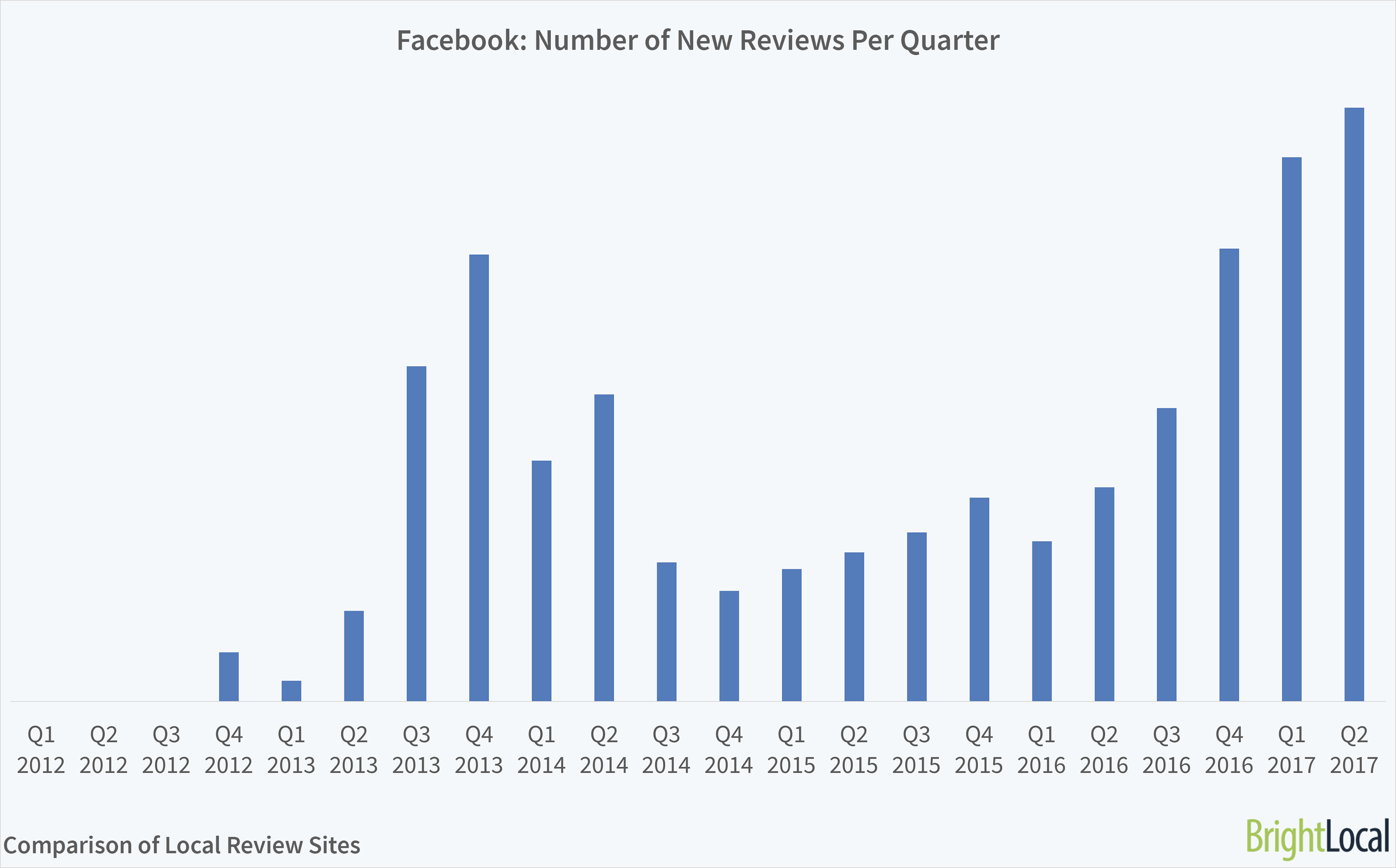
Facebook reviews rapidly took off following their introduction in late 2012. The December 2012 announcement of Nearby meant users could share their recommendations easily with friends for the first time, explaining the rapid percentage growth as seen in 2013.
In 2013 and 2014, Facebook led on reviews – with businesses clearly clamoring to be on the popular platform. But from 2015, Facebook could no longer rely on being the most popular source of reviews.
Don’t worry though, Facebook isn’t failing – it’s just growing at a slower rate than frontrunner Google. By November, Facebook had achieved growth of 64% on 2016. It’s not losing out as more consumers turn to Google – but could begin to receive fewer reviews in 2018 if it doesn’t encourage users to share their views.
Facebook’s recent news feed changes could affect the visibility of publishers and brands, and instead give more prominence to posts that generate discussions. This could affect which businesses users see. This could mean local businesses need to increase Facebook paid advertising, or turn to the Facebook Local app to continue being seen on the platform by potential customers.
Facebook Local is a separate app which has so far seen limited success. The Google Play Store estimates downloads as between 100,00 – 500,000 (January 2018) – far lower than Yelp’s 10-50 million Android users, or TripAdvisor’s 100-500 million. It will need to reverse this trend to continue to be a trusted platform for reviews.
Yelp Reviews
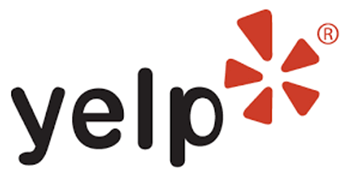
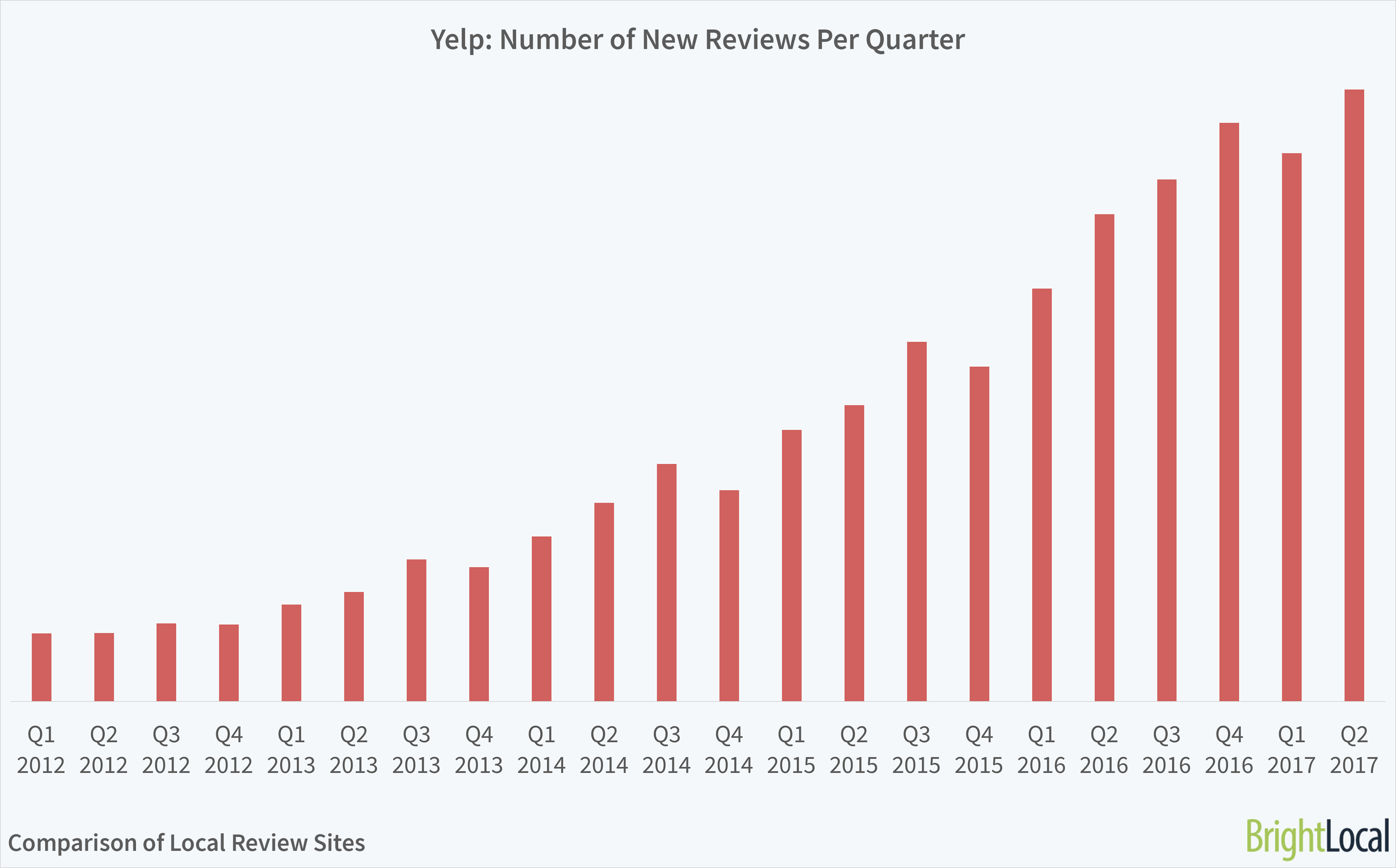 Yelp has been a steady performer over the years, but its growth appears to have slowed recently. In each year prior to 2017, Yelp reviews grew between 55% and 68% on the previous year. It received fewer new reviews in Q1 of 2017 than in the previous quarter, although this did grow again in Q2.
Yelp has been a steady performer over the years, but its growth appears to have slowed recently. In each year prior to 2017, Yelp reviews grew between 55% and 68% on the previous year. It received fewer new reviews in Q1 of 2017 than in the previous quarter, although this did grow again in Q2.
2016 was a difficult year for Yelp, with the platform announcing a scaleback in operations outside North America, and culling further international expansion plans. In May 2017, Yelp’s stocks dropped by 30%after showing disappointing sales.
These recent difficulties appear to be in line with the smaller growth in new reviews – and could indicate that Yelp have recognized their troubles ahead of the review downturn. But, it’s not all bad news, as it is still growing – albeit at a slower rate – with May, June, and July 2017 each surpassing every month before in the number of reviews received on the site.
The big news from Yelp in 2017 was its firm stance on businesses asking for customer reviews. While authenticity should be paramount to any review strategy, actively discouraging asking for these could result in Yelp receiving fewer reviews going forwards. It’s highly possible that businesses will turn to other review sites, rather than stopping asking customers to leave reviews at all.
Tripadvisor Reviews
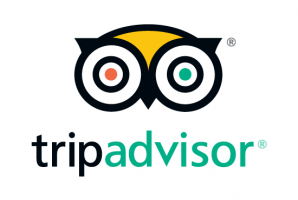
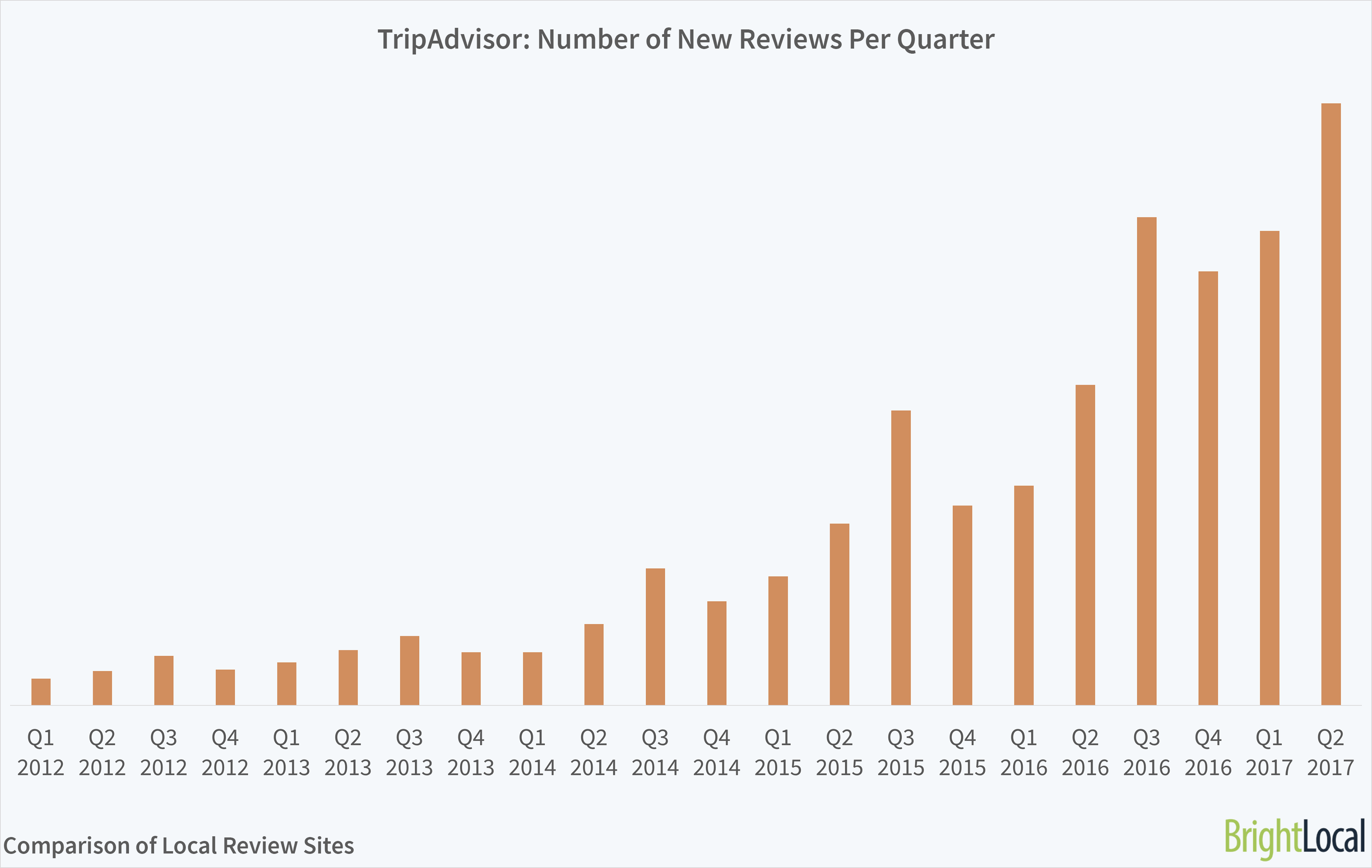
Due to its niche focus, it’s no surprise that TripAdvisor doesn’t acquire as many reviews as Google, Facebook, and Yelp. The travel specialist appears to be slowing in percentage growth – but it is still growing! In 2015, the number of reviews grew 115% on the year before, and a further 82% 2015-2016. It had a particularly strong Q2 in 2017 in the number of new reviews.
As a business, TripAdvisor had a tumultuous 2017, with results falling below analysts’ estimates. The Financial Times reported that “TripAdvisor shares have declined 15 per cent so far this year amid concerns that the company will struggle to turn audience growth into revenue growth.” It’ll be interesting to see if these difficulties reflect in future new reviews on the platform.
Niche review sites may attract fewer total reviews than the big three review platforms do, but they’re still incredibly important within industry sectors. Local businesses should ensure they receive reviews across each of the relevant platforms – making sure to consider where their customers and audiences are looking to find out more.
Foursquare Reviews
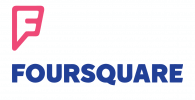
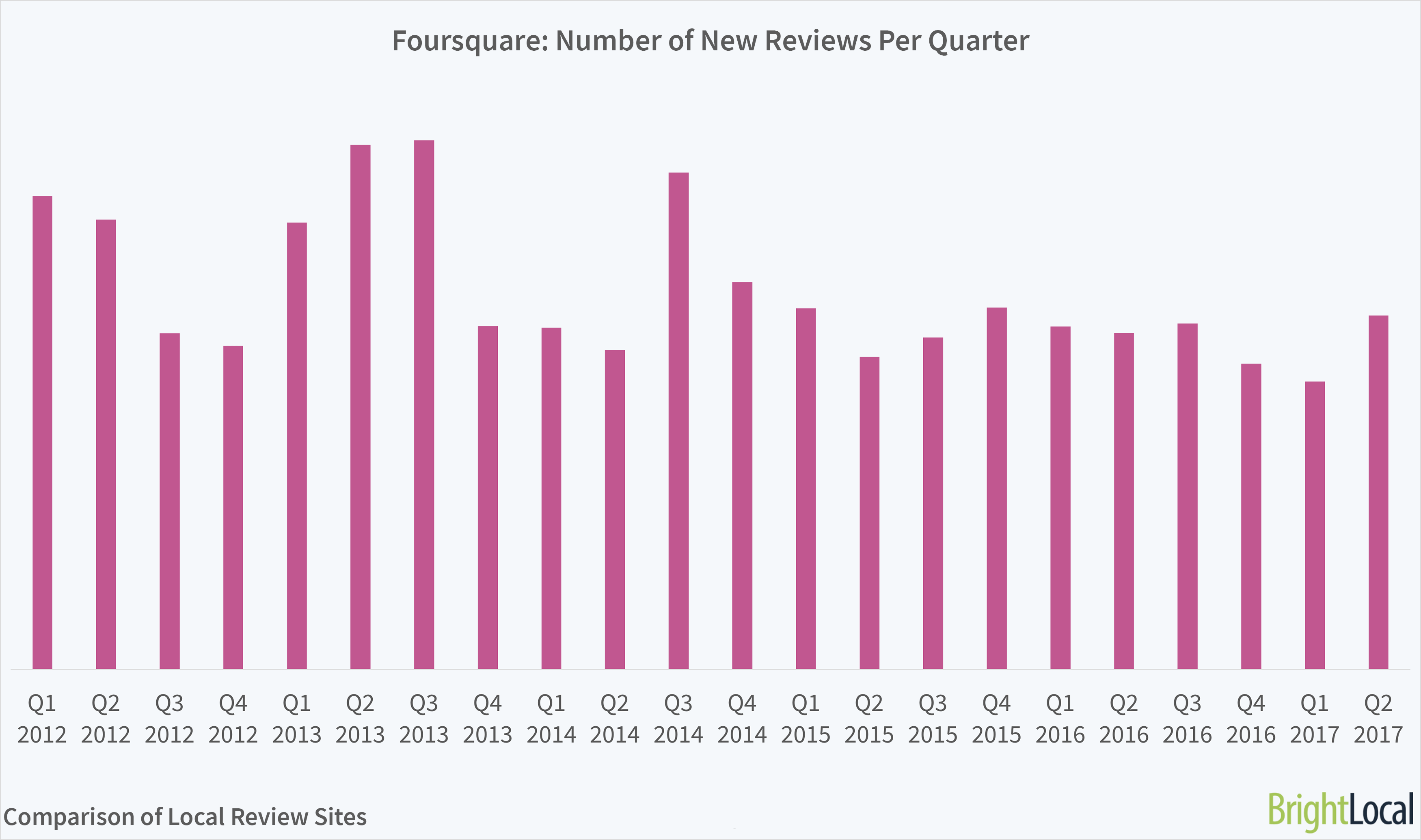
Foursquare’s comparatively low reviews rates will come as no shock. While it no longer competes as a leading reviews platform, it instead excels with its incredibly accurate location data. There have been predictions about Foursquare ending its focus on consumer recommendations, and instead selling its significant data set. Its future remains to be seen.
Loyal users of City Guide can use Foursquare’s data set to find recommendations where they are – although clearly there are fewer reviews per business than other platforms offer. The average consumer reads 7 reviews before trusting a business, so Foursquare might not be the place to go to receive sufficient information.
How Traditional and Digital Marketing Work Together to Power Your Business Goals

Traditional marketing has drastically changed through the evolution of the digital age, and the societal integration of social media. The past 15 years of revolutionary change has caused confusion, doubt, and misunderstanding. Leaving many marketers in the lurch as they attempt to navigate in an ever-changing advertising landscape.
As a result, some are ditching traditional methods completely in hopes of online techniques bringing them holy grail-like ROIs they once experienced. According to Above the Fold’s Traditional Media Strategist Charlie DeNatale, “Traditional media is not broken. What needs to be fixed is the mindset change of what traditional media’s role use to be and what its role is today.”
While digital media strategy is highly important and necessary for producing results and to compete, using a combination of traditional and digital marketing techniques is proving to be the most effective method to elevating success.
The combination of traditional and digital is a one two punch for driving awareness and sales. When combined, they compensate for each other’s weaknesses and so the benefits of both plans are gained as they work in synchronicity.
How to Marry Traditional and Digital Marketing
1. Multiple Channel Approach
By taking advantage of a wider range of traditional and digital techniques, you’re putting your company’s message in front of a diversified audience. For example, a placement during on a cable network like the Hallmark Channel will most likely reach an older audience, while a placement during a teen drama on Hulu will hit a chord with a younger audience.

Depending on the target, some media outlets and types are more successful than others, especially when you consider that a younger audience is more digitally savvy than say their parents’ generation. Using both methods allows your company to reach the full spectrum of potential customers.
One brand that seamlessly integrates both a traditional and digital strategy is fast food chain, Wendy’s. Through their social channels they’ve built a rabid following, eager to consume and interact with the brand through their regular roasting of competing brands and Twitter followers. Their savage tweets have brought a whole new generation of Wendy’s fans and patrons into the fold. They also regularly utilize traditional channels like TV commercials, print, and billboards to attract new and old customers to their restaurants.
2. Segment Campaigns by Active & Passive
Figure out first what your company’s objectives are with your campaign. Is it brand awareness? Driving sales to a new product offering? Introducing your brand to a new generation?
Then you can segment your campaign strategy based upon the activity of the consumer. Traditional marketing is considered to be passive, while digital marketing involves targeting a specific audience, making it active.
While they may be segmented by audience or purpose, they can still maintain a common thread to boost the success of the campaign’s overall goals.
One common thread could be a hashtag. Ask your social followers to take a picture with your product and use the hashtag to be featured or win a contest. Place this same hashtag in our traditional media placements to spread it far and wide, giving it visibility beyond the digital sphere.
3. Get Personal
The amazing result of digital marketing is how its given brands and small businesses the ability to connect with consumers at a deeper personal level. Gone are the days where a customer has to go through the customer service department to get a question answered or a problem resolved. All they have to do is leave an Instagram comment or Tweet at the business and typically within no time they’re getting a direct reply from the company; building trust and affinity.
With social media’s personal touch it’s now more important than ever to have a strategic approach when considering traditional media. Not just what you buy, but how you buy it, how it supports a digital campaign and the influence it has on SEO, PPC, website traffic, and sales.

A great example of a company using traditional and digital to get more personal with their consumers is online fashion retailer, Asos. They release a regular Asos Magazine that features not only their latest fashions and product offerings, but articles related to pop culture, rising stars and musical acts, and other millennial targeted pieces.
Every item featured in the magazine can then be found on a dedicated page titled, “Shop the Asos Magazine.” This gives the reader the chance to emulate their favorite starlet or take the look from the page, and wear it in real life.
It’s a strategy that’s working. Especially when coupled with their hashtag #asseenonme, which encourages their followers to use the hashtag with their Asos look for a chance to be featured on their 6.7M follower Instagram account.
How good is the hashtag working? To the sound of 676,609 photos and counting. Getting personal is the key to building a cult following, or at the very least an audience that’s dedicated to your brand.
In the End, Take a Holistic Approach
Shrewdly evaluate your current traditional and digital efforts with a holistic approach. Understand the “Balance” of your budget allocation between traditional and digital. Use the techniques together to create a cohesive marketing strategy that drives tangible results for your business. If you’re not using both than your business may not be attracting all of your potential customers.
Above the Fold can help you apply these techniques and develop a strategic traditional and digital marketing plan. Contact us today at 760.613.1212 to learn more!
The Ultimate Guide to Small Business Goal Setting for 2018

15 Resources for Effectively Setting and Achieving Goals in Your Small Business in 2018.
Every single small business owner, in any stage of the business life cycle, needs goals to keep moving forward, get them motivated to do more, and maintain the success of their businesses. Goal setting can follow many different processes, and each one can be successful as long as it defines the long- and short-term goals and devises a plan for getting there.
Here is a collection of resources that will help you maximize your process and guide you as you achieve your business goals, from the simplest to the most ambitious goals on your list.
Getting Started with Goal Setting

There’s no denying the importance of business goals. Goals provide direction, motivation and a clear way to measure your progress. Without goals, you may struggle to find the path from where you are right now to where you want to be.
The tips in this article will help you get started with goal setting for your business, focus on the specifics of what you hope to accomplish, and start to put your plan into action.
30 Minute Goal Setting Cheat Sheet
It doesn’t have to be a long and complicated process. You just need to pick a theme, identify the necessary action items and make a commitment to the process. If you have just 30 minutes, you can follow these four simple steps to create a goal for your small business.
SMART Goal Setting 101
Whether you have a 50-employee company or an empire of one, your business success depends on your ability to set and achieve goals. This article will introduce you to the concept of SMART goal setting and help put your business on the fast-track to goal setting and achievement.
7 New Year’s Resolutions that Will Change Your Small Business
New Year’s resolutions can be a powerful way to kickstart goal setting. A resolution, after all, is a decision to do something differently to bring about positive change. This article outlines seven possible resolutions you should set this year.
3 Easy Steps for Turning Your New Year’s Resolutions Into Powerful Goals

A resolution on its own is meaningless. It’s when you create a plan that focuses on the desired results of your decision that the magic happen. These three easy steps will help you turn your resolutions into goals you can focus on in your business.
4 Common Small Business Goals to Inspire You
If you’re having difficulty identifying the right business goals for you, this article is the one you should read first. While there are many different business goals you can set, sometimes the most common are also the most relevant.
This article looks at four common business goals and provides a number of resources that will inspire you to get started.
5 Common Small Business Goal Setting Mistakes
Avoiding mistakes can save you a significant amount of time and effort down the road. So in order to make your goal setting as efficient as possible, this article lists five common goal setting mistakes you should try to avoid in your small business.
How to Reach Your Biggest, Most Pivotal Goals

The only way to make goals count is to give them the attention they deserve. Here are some tactics to use this year as you set new goals and commit to seeing them through to fruition.
Backward Goal Setting
When you are overwhelmed by the idea of setting goals, it can be helpful to start at the end and work backward. This tutorial will walk you through the process of creating realistic goals that are broken down into single actions you can focus on one at a time.
How to Set Business Goals with Just One Word
Creating a goal with just one word is a way to eliminate the overwhelming part of the goal setting process and focus on a specific theme. Here’s how to start.
Goal Setting & Tracking Apps

Having a system for setting and tracking your goals is an important part of the goal setting process. Without a system, it would be impossible to identify a goal, create an action plan and track your progress.
This list of goal setting and tracking software will help you create, track and achieve your most important business goals.
10 Powerful Goal Setting Steps
Envisioning your ultimate business goal may not be that difficult, especially if you are a driven and determined business owner. Figuring out how to achieve that ambitious goal, though, can be another story.
Returning to the basics of the goal setting process is one way to get and stay on track with your business goals, and getting motivated and inspired is another. This article focuses on both.
Tips for Successful Goal Setting & Achievement
There are a lot of moving parts when it comes to goal setting. The good news is that you can do a few things that will help you create an environment that is conducive to goal setting success. Taking the time to work on the items listed in this article will help reduce the challenges that come with tackling your biggest goals.
How to Get & Stay Motivated
Without the motivation to work hard and overcome challenges, you may find yourself in a slump, and worse, you may lose your passion for achieving your goals. Motivation is vital for any goal setting process; without it, it will be very difficult to reach your goals.
Review these tips for getting and staying motivated when you’re striving to accomplish your goals so you can build momentum and push through challenges with ease.
6 Alternatives to Traditional Goal Setting
Sick of traditional goal setting? Try one of these six alternatives that can help you create a new focus and intention in your business for the coming year.
If you’re interested in speaking to us about how we can help you achieve your marketing goals this next year please contact Matt at matt@abovethefoldagency.com. Cheers to a successful and prosperous 2018!
8 Productivity Quotes from Top Entrepreneurs to Fuel Your Work Day

As business owners big and small our time is precious, in fact it may be our most valuable asset. When we’re being pulled between internal or clients meetings, deadlines, or a never ending unread inbox our productivity decreases as a result. Making it even harder to find a moment to recenter and focus the mind on what’s actually important.
However, finding moments to gain clarity and foster creativity are essential to long term success (and let’s be honest, sanity)!
Thankfully there are those that have gone before us and found ways to boost productivity in their daily lives and businesses. Here’s how they’ve done it:
1. “Have a clear system for to-dos: whether it’s ‘Getting Things Done’ or the ‘Checklist Manifesto,’ just have a system and stick to it. I have a very specific method I use in Slack and in email that works for me, and knowing I have that system keeps me from feeling overwhelmed even when I’m behind or the to-dos pile up.” —April Underwood, Vice President of Product, Slack
2. “The key for me is you have to understand how your brain works and when you are most productive. For me, I’m most productive and creative in the morning through early afternoon, so I’ve gotten rid of lunch meetings to keep my productive time going as long as I can. I make sure the tasks I have at the beginning of the day are the tasks that require the most creativity or, in other words, tasks I have never done before.” —Ryan Smith, CEO and co-founder, Qualtrics
3. “Dream big. Start small. But most of all, start.” —Simon Sinek, Author & Motivational Speaker
4. “Inbox zero is a fool’s errand. I don’t try to keep up. I feel perfectly fine picking and choosing what I want to engage in.” —Jeff Lawson, CEO, Twilio
5. “Never procrastinate. Just get it done right away. I don’t wait until I get home, I take calls wherever I am. I execute on any feedback I get right away. That way, the work never piles up.” —Anthony Tan, CEO and co-founder, Grab
6. “Don’t build links. Build relationships.” —Rand Fishkin, MOZ
7. “Turn off everything—email, phone, stock tickers, news, etc.—as often as possible and focus on a single task without interruption.” —Dianne McKeever, Co-founder and Chief Investment Officer, Ides Capital
8. “Think big and don’t listen to people who tell you it can’t be done. Life’s too short to think small.” —Tim Ferriss, Author of The 4-Hour Workweek
Why Going Cheap on Your Branding Is One of the Worst Mistakes You Can Make

Going cheap on your brand development could not only lead to a disconnect with potential customers, but could also result in your company shutting its doors as a result of low sales.
Your brand has a life.
Believe it or not, this thing you’ve created has legs to stand on, living and breathing every day. While this may sound high-minded, statistics prove otherwise. According to a study compiled by Bop Design, 54 percent of people don’t trust brands. But for those who do, 64 percent cite sharing a common bond with the brand as their primary reason for following or purchasing from them.
Why is this the case? Because your brand is your business’s first impression, and if done poorly, possibly the last. To some, branding seems like a luxury investment (and in some cases, this is true). However, going cheap on your brand development could not only lead to a disconnect with potential customers, but could also result in your company shutting its doors as a result of low sales. It’s a nightmare scenario for most entrepreneurs, which is why I’m going to go over a few reasons why investing in your brand is one of the wisest investments you could make.
A story you can sink your teeth into.
Breathe life into your business with a brand story or mission statement. Let’s be honest, coming up with your brand’s story is not an easy task. It’s going to take a lot of self-reflection and doubt, running through your purpose as to why your business exists in the first place. Additionally, this mantra will be what dictates every piece of copy or content your company puts out, creating a skeleton of how your voice will sound.
Let’s look at Whole Foods. The company could have created a wholesome-looking logo to lure people through its doors, but the multi-national retailer takes careful measures to back up its introduction to consumers. The brand has built a foundation of offering healthy and nutritious foods, and this foundation informs every marketing initiative and company development. From offering in-store educational experiences to teach consumers about food and emerging brands to getting involved in community-building programs through donating food to shelters and supporting local vendors, Whole Foods doesn’t just view its brand story as a marketing ploy, but leans on its pillars to guide the brand forward.
As Kissmetrics points out, there’s an actual science to what we deem as an authentic brand story. This breaks down to what’s essentially called neural coupling, or the emotional connection we feel when hearing a story. However, reaching this point might not be easily solved on your own, especially if you’re in a time crunch to launch.
While it’s up to you to have an agency or consulting firm take over your entire branding objectives, a lot of this is going to come from you. It’s not a bad idea to gain an outside perspective from someone to ask you the tough questions on why you started your business and what it represents, as well as where exactly you want it to head. The love you feel for what you’ve created is something most will understand, which is why having a third party pull the beauty of that out of you and translate it in a way others can comprehend is vital.
Because once you release your brand to the outside world, the perception of what it represents no longer belongs to only you anymore.
Your brand is more than just a logo.
A common misconception by novices in the branding world is making the assumption that a logo and a brand are synonymous. While your logo is one of the most important visual assets for your company — it is just the beginning. From there, you need bring your brand to life by embodying your values through marketing initiatives, product development and customer experience enhancements. Your brand’s goal is to represent an idea or shared truth between you and your audience, and that shared truth should permeate into the ethos of your business. It’s a common bond that drives towards a specific mission, which is something you’re going to miss the mark on by simply going for a cheap logo with the idea you’ll fix it later on.
When it comes to your logo, this symbol is going to represent an ethos that reflects upon how your company is aiming to change the world. Take the Whole Foods logo, for example. Many consumers in every major market across the country not only instantly recognize the green Whole Foods font, but new consumers also immediately recognize what the Whole Foods brand stands for thanks to the homage its logo pays to fruit and natural foods.
There’s plenty of places you can get a quality logo that won’t break the bank (I recommend checking out Deluxe). Remember, your logo is literally going to be everywhere your company is, so make it worth the ink it’s printed on. Plus, when done right, your logo is going to serve the purpose of telling your brand’s story without saying a word. So you have your logo … now what?
People talk, so you should listen.
How your brand is going to interact with the outside world will largely dictate the success of your company. From trade shows to social media, every interaction can give a valid perspective on who your company actually is. As Pew Research notes, more than 68 percent of all U.S. adults are on social media, so the potential amount of feedback you might receive could be tremendous.
Your brand is going to represent that universal truth you share with your consumers. Although discovering this is going to be tough, the rewards will be tremendous. People will no longer just be fans, but evangelists for what you’re about. Which begs the question: Are you ready to not just tell your story, but make it one that can stand the test of time?
About Andrew Medal: He is the founder of creative digital agency Agent Beta. He has helped organizations like the California Education Department, Proctor & Gamble, Microsoft, Warner Bros. and Inc. Magazine.
Beginner’s Guide to Influencer Marketing (& How it Boosts SEO Ranking)

It seems everyone you meet these days is a self-proclaimed influencer. Whether that’s over a multi-million plus following or their local book club, the significance of influencers has entered our daily lexicon and lives, and guess what, it’s here to stay.
As a business in 2017 it’s a marketing resource you can no longer neglect. In fact, a recent emarketer survey found that 84% of marketers intend on launching at least one influencer campaign in the next 12 months. Even more staggeringly, 94% of marketers from a variety of industries said influencer marketing was an effective strategy.
Finding key target influencers to develop strategic partnerships with will only take your brand and business to the next level.
Before diving into the complexities of a full frontal influencer campaign let’s go over the basics with this Beginner’s Guide to Influencer Marketing:
What in the World is an Influencer?
First, let’s take a step back and define influence.
In·flu·ence
Noun
- the capacity to have an effect on the character, development, or behavior of someone or something, or the effect itself.
With this in mind, an influencer is a person, or even in some cases a furry friend, that has established a level of authority and trust amongst their niche audience.
Unlike celebrity endorsements, influencers carefully select their affiliations, opting to partner with brands that reflect their personal branding and don’t alienate their followership. This close connection to their audience has fostered an environment where fans follow their every move, trusting their word sometimes above their very own friends and family.
Essentially they’ve curated the ability to affect and control customer purchasing decisions, and drive consumers to brands over others. Making them the ultimate potential trendsetter for your brand.
What’s amazing about an influencer is they can take many shapes and forms, and the term does not only apply to fashion and beauty bloggers. An influencer can be a journalist, author, commentator, industry insider, blogger, celebrity, happy customer, and the list goes on.
The ultimate goal with influence is to generate positive brand perception and awareness in a truly authentic and unique way. You’ll be in wonder of what some influencers can create with your brand!
Why Influencer Marketing Matters
Nearly 40% of Twitter users say they’ve made a purchase as a direct result of a Tweet from an influencer, according to Twitter.
With numbers like that, influencer affected purchases clearly aren’t are a one-off.
So let’s take a peek at a few successful influencer marketing campaigns that clearly illustrate Tomoson’s findings that “Influencer marketing was rated the fastest-growing online customer acquisition channel, beating organic search, paid search, and email marketing.”
Ok numbers, do the talking:
1. Lulus
We’ll start with coveted and viral fashion online store, Lulus. Started a number years ago as a fast-fashion ecommerce brand, now has transformed itself into every it girl’s go-to for chic and affordable looks.
What led to Lulus explosive growth and cult status? Influencer marketing. How did they do it?
Lulu’s partnered with fashion bloggers that fit their branding. By reaching out to bloggers of varying and diverse followers they were able to tap into a wide, yet targeted audience.
They then provided these bloggers with the ability to select clothing, shoes, and/or accessories that fit their own personal brand. Then encouraged them to share how they styled their Lulus look with their followers on social media and their blog, and of course, without forgetting to include the #lovelulus hashtag.

As you can see in the example above, by supplying @nicholeciotti with a dress (and possibly some payment) they put themselves in front of her 450K+ audience that attracted 14K+ likes. All while advertising in a way that’s natural and ultimately led to purchase conversions through her delicate call-to-action.
Lulus has built a business on this type of seemingly easy breezy influencer marketing. Imagine what you can do with your business!
2. Suja Juice
We couldn’t speak about influencer marketing without mentioning local San Diego company, Suja Juice! To say their Midnight Tonic campaign went viral, would be a major understatement.
And if you can believe it… they were able to get their products in the hands and in the feeds of major celebrities, influencers, and raving fans alike at no paid promotional cost.
Let’s dive in and learn how they pulled it off!

In September 2016, Suja Juice released Midnight Tonic, an all black, limited edition charcoal based beverage to health conscious celebrities with an active social media presence.
A fever pitch ensued, with fans clamoring to get their hands on one of the 1,000 bottles available they witnessed their favorite celeb devouring with enjoyment. The madness caused the site to crash and the product to sell out in three days.
A few of the celebs and outlets that organically posted on a variety of platforms about their experience were Eva Longoria, Jesse McCartney, Kristin Cavallari, and PopSugar.
The campaign generated an awe-inducing 16 million social impressions. Not to mention, countless new customers along the way. All achieved without paying anyone for the endorsement.
What gives this campaign more heart, and meaning beyond tallying up the numbers is how CMO Heather MacNeil Cox described their thought process.
“We chose influencers that have been organic fans of the brand since the beginning, people that love and drink Suja on their own. The Midnight Tonic surprise shipment was a way to thank them for their support, and also re-engage in a conversation about something new and cool.”
Ultimately, the immense success of this campaign stemmed more from the thought process of showing gratitude, rather than focusing solely on how many celebrities they could get to show off their product.
The organic nature of the celebrities’ show and tell of the limited edition Midnight Tonic and their need to be early adopters is what drove the tonic’s virality; the authentic display of a health beverage so tangibly intangible that everyone had to have just a taste.
Suja Juice, we salute you.
Perks of Successful Influencer Marketing & How it Impacts SEO
On a simplistic level the goal of SEO is to achieve links directed to your site from high ranking and authoritative sites in order to drive your rankings for specified keywords to Google’s lauded first page.
You may be thinking if you just get a few solid links from influencers then you’re golden, right? Not so fast turbo.
Link building is much more complex, and so let’s break it down in regards to how partnering with influencers in a strategic way is indeed a boon for your overall SEO goals.
Campaigns need three types of links to grow overall domain authority, as we’re assuming you’re striving to rank specific keywords and phrases on your site.
- Broad, High Domain Authority: This link will point to any section of your website, whether that’s the home page, an internal page, blog, etc. An example, would be Huffington Post, a highly authoritative web news source with a wide reach.
- Specific High-Value Keyword Targeted Pages (with specific anchor text): By doing this individual URLs’ rankings will receive a needed boost. The easiest way is to provide a keyword and associated link for the influencer to place into the copy of their blog post about your product or service. Thus making its inclusion seamless and natural.
- Topical Influence: In other words, links to your domain from other sites within the same niche that give your site more authority and influence in your sector. This linking strategy is particularly pertinent to influencer marketing partnerships. If you’re a technology startup with a revolutionary product, you want to get into the hands of bloggers and journalists who write about the latest and greatest in tech.
While the above may feel a tad overwhelming, if you get it right, you’re ensuring yourself a goldmine of opportunities to drive web traffic and revenue. Not only that, you’re giving your business the opportunity to build relationships with influencers who will become forever fans whether paid or not.
The time really is now to get in on the influencer marketing game. To learn more about how influencer marketing can support the growth of your business, check us out at https://abovethefoldagency.com.


